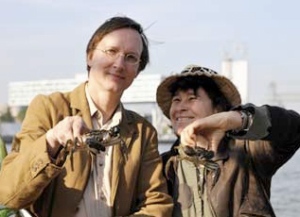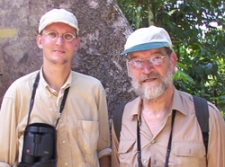 Kees Moeliker writes and speaks about natural history – especially birds and remarkable animal behaviour – improbable research and science-communication-with-a-laugh. He is the director of the Natural History Museum Rotterdam, European Bureau Chief of the Annals of Improbable Research, and winner of the 2003 Ig Nobel Prize in biology. He wrote the bestseller ‘De eendenman’ (The Duck Guy, 2009; translated into German Der Entenmann in 2018) and presented the TV-series ‘Fauna & Gemeenschap‘ (2009, 2010). His column ‘beest’ in NRC Handelsblad made it into books, titled ‘De bilnaad van de teek’ (The butt crack of the tick, 2012), and ‘De kloten van de mus’ (November 2016). Each year, on June 5th, he organises ‘Dead Duck Day‘
Kees Moeliker writes and speaks about natural history – especially birds and remarkable animal behaviour – improbable research and science-communication-with-a-laugh. He is the director of the Natural History Museum Rotterdam, European Bureau Chief of the Annals of Improbable Research, and winner of the 2003 Ig Nobel Prize in biology. He wrote the bestseller ‘De eendenman’ (The Duck Guy, 2009; translated into German Der Entenmann in 2018) and presented the TV-series ‘Fauna & Gemeenschap‘ (2009, 2010). His column ‘beest’ in NRC Handelsblad made it into books, titled ‘De bilnaad van de teek’ (The butt crack of the tick, 2012), and ‘De kloten van de mus’ (November 2016). Each year, on June 5th, he organises ‘Dead Duck Day‘
Kees Moeliker was born in Rotterdam, the Netherlands in 1960. As a schoolboy he wandered in the fields and marshes surrounding the city, looking for birds. His first real discovery dates back to April 1973, when he observed the first Egyptian goose (Alopochen aegyptiacus) ever seen in the Rotterdam area. He studied biology and geography, and – as a student – got deeply involved in the population-ecology study of the House Sparrow (Passer domesticus) conducted by his mentor, friend and neighbor Kees Heij. After working in a butcher shop, teaching English in Istanbul, guiding nature tours in Costa Rica and teaching biology at several high schools, he was appointed education officer at the Natural History Museum Rotterdam in 1989. He still works at the museum, till 2015 as chief-curator and head of communications, now as director.
He studied biology and geography, and – as a student – got deeply involved in the population-ecology study of the House Sparrow (Passer domesticus) conducted by his mentor, friend and neighbor Kees Heij. After working in a butcher shop, teaching English in Istanbul, guiding nature tours in Costa Rica and teaching biology at several high schools, he was appointed education officer at the Natural History Museum Rotterdam in 1989. He still works at the museum, till 2015 as chief-curator and head of communications, now as director.
As an ornithologist his main achievements are the rediscovery and securing of long-lost birds: in 1991 (together with Kees Heij) the Black-chinned Monarch (Monarcha boanensis) on the remote Moluccan island of Boano; and in 2001 (together with several colleagues and an Indonesian counterpart) Bruijn’s brush-turkey (Aepypodius bruijnii) on the Papuan island of Waigeo. Together with several other specialists, he contributed to the chapter dealing with the family Monarchidae in the Handbook of the Birds of the World (volume 11, 2006).
Flying mammals also interest him. He collected and subsequently described a new subspecies of fruit bat (Macroglossus minimus booensis Kompanje & Moeliker, 2001) endemic to the remote West-Papuan island of Boo.
Closer to home, he secured and preserved the remains of the now immortal ‘Domino Sparrow’, the house sparrow (Passer domesticus) that was brutally shot in the Netherlands in November 2005 after she threatened to ruin a domino-toppling world record attempt. The bird’s dramatic death caused public outrage, and so did the outrage itself. The mounted specimen is now an ‘icon of Dutch culture’, and one of the most beloved pieces of the Natural History Museum Rotterdam. In 2007, alerted by a medical report about the local decline of the pubic louse, Moeliker campaigned to collect and preserve ‘the last of the pubic lice’ for the collection of the Natural History Museum Rotterdam, were specimens of Phthirus pubis were lacking. Results were meagre, but the amount of publicity huge.
Moeliker always has a keen eye for strange bird behaviour. In 1995 he was the first to witness a case of homosexual necrophilia in the mallard duck. In 2003, his publication about this observation [‘The first case of homosexual necrophilia in the mallard Anas platyrhynchos (Aves: Anatidae)’] earned him the Ig Nobel biology prize, the award that honors ‘research that first makes you laugh, then makes you think’. Since then he is know as ‘ the duck guy’ and has joined the editorial board of the Annals of Improbable Research. He also appeared annually on stage at the Ig Nobel prize ceremony and is a regular performer during the annual Ig Nobel Tour of the UK. In May 2006 he was appointed European Bureau Chief of Improbable Research, the US-based organization that publishes the bi-monthly Annals of Improbable Research, produces the website improbable.com and organizes the annual Ig Nobel prize ceremony.
 He publishes his observations and thoughts in NRC (a leading Dutch newspaper), on the improbable.com blog, and he did so in the Dutch edition of National Geographic Magazine. Kees had a weekly science talk on Dutch public radio till August 2010 and he is still a regular columnist of the Vroege Vogels radio show.
He publishes his observations and thoughts in NRC (a leading Dutch newspaper), on the improbable.com blog, and he did so in the Dutch edition of National Geographic Magazine. Kees had a weekly science talk on Dutch public radio till August 2010 and he is still a regular columnist of the Vroege Vogels radio show.
In February 2009 his first book ‘De eendenman‘ (the Duck Guy) was published. The book is about homosexual necrophilia and other remarkable animal behavior, summarizing ‘discoveries and thoughts of a bewildered biologist’. His second book ‘De bilnaad van de teek‘ (The butt crack of the tick, 2012) was voted ‘best science book of the year’ by the science section of De Volkskrant.
Together with singer Frédérique Spigt, he presented the TV-series ‘Fauna & Gemeenschap’ about urban wildlife in the city of Rotterdam. This series was broad casted in 2009 and 2010 on TV-Rijnmond, and can still be seen on the internet. In 2009 he was the expert (‘the man who knows everything’) in the science quiz ‘Echt niet?! on Dutch National TV (Teleac/VPRO). In 2016 he tried to write a literary thriller in the television series ‘De pennen zijn geslepen’. He almost made it to the final episode.
Besides his work on birds, bats, natural history and improbable research, Kees Moeliker is an avid collector of (top quality) binoculars. He also collects his own organs. So far this collection only contains his gall bladder that was removed (with a fine gall stone specimen) in January 2010.



Pingback: Improbable Research Collections - NewTeeVee Station
Pingback: Improbable Research » Blog Archive » “The Duck Guy” — reprinted, plus museum exhibition
Pingback: Improbable Research » Blog Archive » Unusual necrophilia in the swallow
Pingback: Improbable Research » Blog Archive » Ig Nobel Tour of Denmark starts tomorrow
Pingback: Miss Conduct’s Mind Over Manners | Ig Nobel Prize Ceremony tickets on sale!
Pingback: Improbable Research » Blog Archive » The Case of the Decapitated Canary